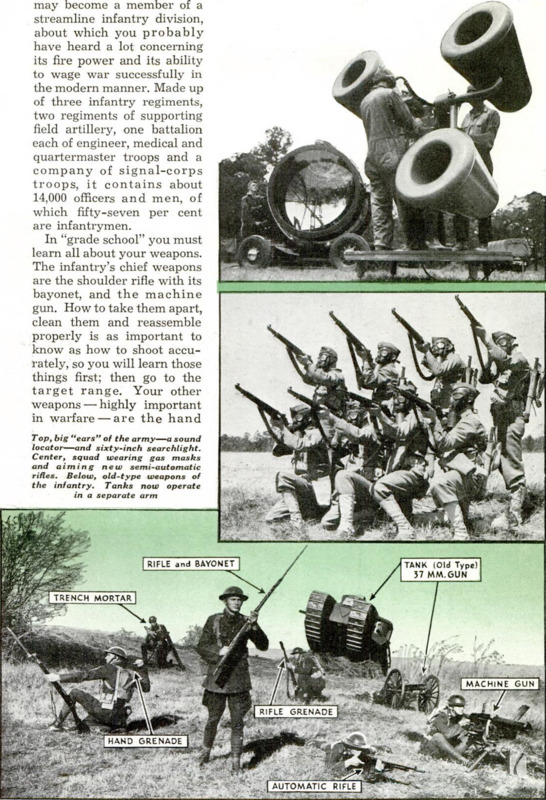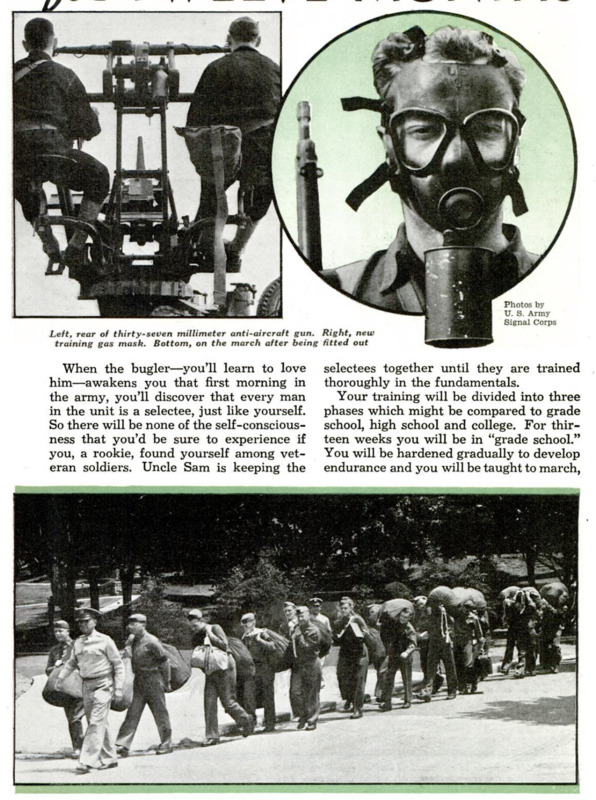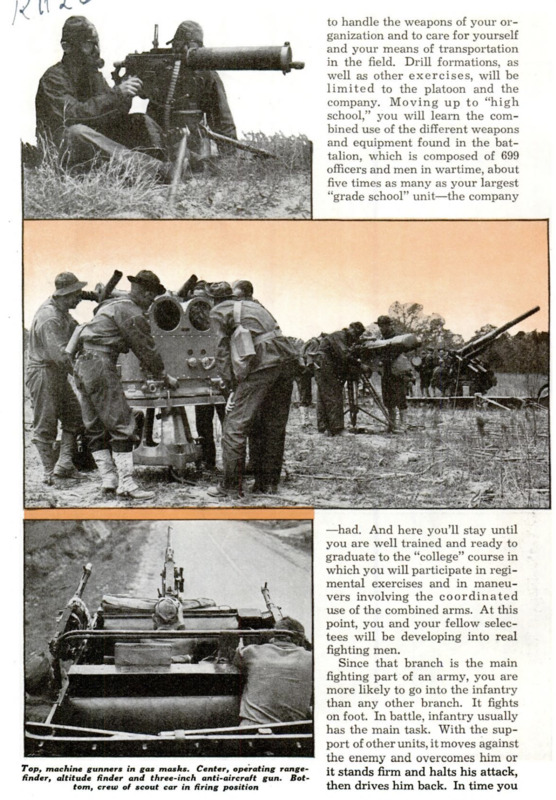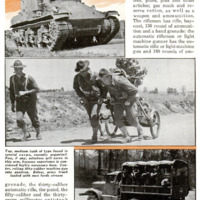LETS suppose your number has been drawn, the local board’s examination has resulted in orders for you to report for the twelve months training required by the Selective Service Act and you're wondering what comes next. Mister, you're in the army now, although you will go through three or four days of preliminaries before you become fully conscious of it. You, and others called at the same time by your local board, are on your way to one of the 100 induction stations - similar to recruiting offices - set up throughout the United States. From there you will go to a reception center for your first real contact with the U.S. Army. Your records will be completed, uniform issued, vaccinations administered and you will be interviewed to determine the military duty for which you may be best fitted. Then comes assignment to a particular organization. When the bugler - you'll learn to love him - awakens you that first morning in the army, you'll discover that every man in the unit is a selectee, just like yourself. So there will be none of the self-consciousness that you'd be sure to experience if you, a rookie, found yourself among veteran soldiers. Uncle Sam is keeping the selectees together until they are trained thoroughly in the fundamentals. Your training will be divided into three phases which might be compared to grade school, high school and college. For thirteen weeks you will be in “grade school.” You will be hardened gradually to develop endurance and you will be taught to march, to handle the weapons of your organization and to care for yourself and your means of transportation in the field. Drill formations, as well as other exercises, will be limited to the platoon and the company. Moving up to “high school,” you will learn the combined use of the different weapons and equipment found in the battalion, which is composed of 699 officers and men in wartime, about five times as many as your largest “grade school” unit - the company - had. And here you'll stay until you are well trained and ready to graduate to the “college” course in which you will participate in regimental exercises and in maneuvers involving the coordinated use of the combined arms. At this point, you and your fellow selectees will be developing into real fighting men. Since that branch is the main fighting part of an army, you are more likely to go into the infantry than any other branch. It fights on foot. In battle, infantry usually has the main task. With the support of other units, it moves against the enemy and overcomes him or it stands firm and halts his attack, then drives him back. In time you may become a member of a streamline infantry division, about which you probably have heard a lot concerning | its fire power and its ability to wage war successfully in the modern manner. Made up of three infantry regiments, two regiments of supporting field artillery, one battalion cach of engineer, medical and quartermaster troops and a company of signal-corps troops, it contains about 14,000 officers and men, of which fifty-seven per cent are infantrymen. In “grade school” you must learn all about your weapons. The infantry’s chief weapons are the shoulder rifle with its bayonet, and the machine gun. How to take them apart, clean them and reassemble properly is as important to know as how to shoot accurately, so you will learn those things first; then go to the target range. Your other weapons - highly important in warfare - are the hand grenade, the thirty-caliber automatic rifle, the pistol, the fifty-caliber and the thirty-seven millimeter anti-tank guns and sixty and eighty-one millimeter mortars. It’s no joke when the army says you should be able to |endure prolonged and arduous physical exertion. For instance, your combat clothing and equipment is quite a load at the start and it gets heavier every step of a long march. Here's what you, the infantry soldier, will carry: field uniform, consisting of steel helmet, shirt, trousers, leggings, shoes, underclothes and, according to the season, rain-coat or coat and overcoat; mess kit; canteen and cup in a carrier and first-aid kit on your belt; pack containing blanket, trench tool, shelter tent, poles, pins and toilet articles; gas mask and reserve ration, as well as a weapon and ammunition, The rifleman has rifle, bayonet, 136 round of ammunition and a hand grenade; the automatic rifleman or light machine gunner has the automatic rifle or light machine gun and 180 rounds of ammunition in nine magazines. The machine gunner, ammunition carrier, communications man and tanker each carries a pistol and twenty-one rounds of ammunition. The rifleman’s load is approximately sixty-four pounds; the automatic rifle- man’s or machine gunner’s is seventy-four pounds. Those armed with pistols carry forty-five pounds, but they often have to carry machine guns and other heavy loads for considerable distances. Winter clothing adds seven pounds more. So if you think the modern “army on wheels” provides a “joy ride” for you and your equipment, the first long march with your man-size load will dispel any such idea. It is true that the infantry frequently is transported by truck over long distances and in cases where speed is paramount to attack or defense, but the soldier usually must depend upon his feet under simulated or actual war conditions. If the officer who interviews you at the reception center finds you better fitted for some arm other than the infantry, you may be assigned to the cavalry, the field artillery, corps of engineers of the signal corps, or to one of the supply branches such as the ordnance department or quartermasters corps. The cavalry, which offers plenty of action, is divided into two kinds, horse cavalry and mechanized cavalry. Horse cavalry, when it comes in contact with the enemy, usually dismounts and fights on foot like infantry. Charging while mounted is reserved for surprise attack on small groups of the enemy. Your boyhood complex of wanting to make a loud noise - usually exercised on the Fourth - would get a lot of satisfaction in the field artillery, which employs guns and howitzers to support the infantry and the cavalry. The light artillery includes the seventy-five millimeter gun, the seventy-five millimeter howitzer and the 105 millimeter howitzer, all of which can be moved rapidly from place to place and can. be put into position, ready to fire, in less than one minute. Medium artillery units use the 155-millimeter howitzer and heavy artillery the 155-millimeter guns, eight-inch howitzers and 240-millimeter howitzers. It takes one to six hours to emplace and prepare these heavy weapons for firing and they are moved by large tractors. A problem of major importance to the field artillery during combat is replenishment of ammunition. A single seventy-five-millimeter gun, firing continuously throughout a three-hour battle, used more than 500 rounds of ammunition weighing more than five tons. Hence the field artillery requires large truck trains. Since the men at the guns almost never see their targets, the firing of the field artillery is conducted from observation posts connected with the batteries by rapidly laid telephone wires and by radio. At these observation posts, the accurate computations required for directing the fire are made and the fire is adjusted on the hostile targets either by direct observation or by observers in airplanes or captive balloons who communicate by radio or telephone the data on which fire corrections are based. A recent development is the motorized observation balloon which is transported by a truck equipped with mechanism for raising or lowering the balloon. If you should be assigned to the coast artillery, you'll really be in the big-gun division, for that arm employs sizes up to huge sixteen-inch guns that shoot an armor-piercing shell weighing more than a ton for distances exceeding twenty miles. Harbor defense is the principal duty of the coast artillery and the giant guns are either in fixed positions or on special railway cars that can be moved quickly along the coast and set up for firing out over the sea. The coast artillery also lays fields of electrically controlled submarine mines which can be exploded from shore as enemy ships pass over them. In this work, you might even become something of a sailor, for the coast artillery uses boats, ranging from ocean-going mine planters of 1,000 tons to small motorboats, to install and maintain mines. Also in the coast artillery are anti-aircraft guns, which are supplemented by searchlights of approximately 800,000,000 candlepower which illuminate targets at night. To enable searchlight crews to find the targets quickly as they approach high in the air over the gun, you and other selectees will learn to use sound locators. These are huge aids to hearing - super- sensitive “ears” - by which trained ob- servers can tell the direction from which the sound of approaching airplanes is coming, so the searchlights can be trained on the targets. All this equipment requires the production of considerable electric power in the field and the use of complex and delicate control instruments by highly trained personnel. You'll find your “lessons” not so easy if this is part of your year’s schooling. Perhaps you possess technical skill that will send you to the corps of engineers. There youll learn to build, repair and maintain buildings, bridges and structures of every kind; to blow up bridges, viaducts and roads, as well as captured guns and stores; to dig tunnels under enemy fortifications and demolish them; to construct roads for the army; to operate railways, electric-light and power systems, water-supply systems and all other utilities; to survey and prepare maps for the use of all arms of the service, and to build floating bridges rapidly across rivers. Engineer units are largely motorized. There’s plenty of excitement for you in the signal corps, if that is the arm to which you are assigned. Here are trained the communication men of the army who speed messages by motorcycle, airplane, homing pigeon, telephone, teletype, telegram and radio. In warfare, field wire is laid on the ground by signal-corps cross-country trucks and from man-drawn and man-carried recls. Breaks often occur in these lines during battle and they must be repaired quickly so that commanders can keep contact with their fighting units. So linesmen must leave shelters, follow the wire and often repair the line under fire. You've heard about the “beany, beany” diet in the army, so you'll probably be surprised at the quality and variety on the menu for the next twelve months. It will be as good - perhaps even better food than you've been getting at home, for it’s a balanced diet designed to keep you healthy and strong. There’s going to be some fun scattered through the year - the army’s planned it that way. There will be equipment and facilities for various sports, football, baseball, boxing and the like, and unit teams will compete with one another. Too, there will be movies, service clubs and recreation rooms where you will listen to the radio, read, write, play games and entertain the home folks when they come calling. The army wants no “dull” boys, so you'll play a lot during your twelve months service with Uncle Sam.










